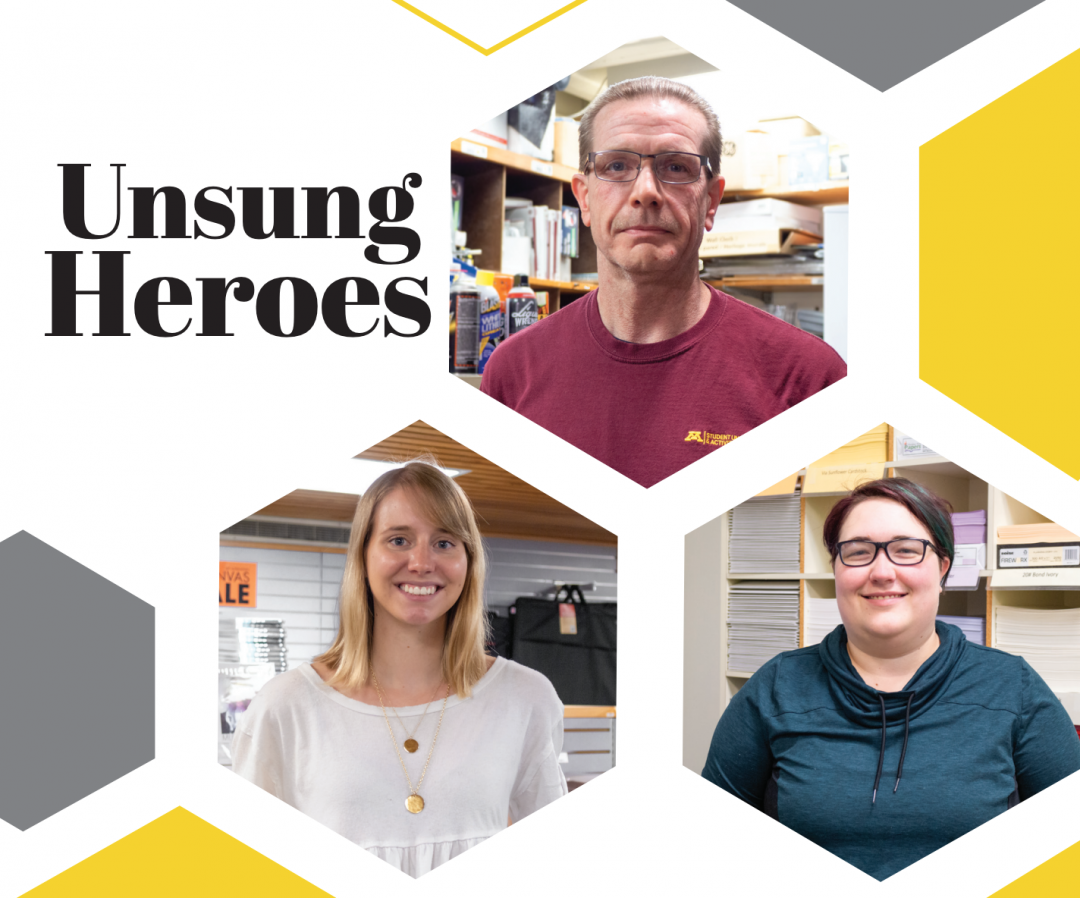
Unsung Heroes
Photos by Charlotte Christiansen
The University of Minnesota is a city within a city. And—as is the case with any large, well-run municipality—a host of laborers, technical experts, and support staff are required to keep the lights on, the shelves stocked and the streets safe.
These 27,000 essential staff members include janitors, mechanics, food service workers, printing shop managers, landscaping experts, office assistants and health care workers. Like U of M students and faculty, the majority of them are skilled, take pride in their work, and care deeply about the community. Yet, few people in or outside the institution’s walls take the time to recognize their contributions.
The following is our humble attempt to bring a few of these unsung heroes out of the shadows.
Black and White and Purple All Over
Kelly Almquist, who recently graduated from college in Kentucky, has worked at the St. Paul Printing Center as a printing service specialist for nearly a year. And whether students know it or not, it’s likely that thousands of them have come into contact with her work or the work of her peers at the various printing centers around campus.
At its heart, Almquist’s job consists of printing documents for customers—whether that be a single-page lab report for a biology class or a final algebra exam or a poster for alumni relations. She enjoys the work, especially because it gives her the chance to interact with student employees. Almquist also takes pride in the impact her work has on these same students’ educational trajectory.
“I think we help out the professors so that they can get their exams and stuff printed so that students can meet the requirements that they need to graduate,” she says.
In addition to working 40 hours per week at the Printing Center, Almquist has a managerial position at Staples. On top of working two jobs, she finds the time to be a full-time Minnesota Vikings fan, watching all of their games on television, attending a few in person and fawning over defensive safety Harrison Smith. She is also an avid reader and book lover.
One of Almquist’s favorite things to do outside of work is attend programs put on by Events and Adventures, an organization she describes as “a singles club.” There’s a fee to join, but Almquist doesn’t mind. People in the group set up different social events and activities, like going to breweries, on trips to places like Florida, camping and attending Halloween parties. Almquist attends most of their events and says she has a lot of fun meeting new people and cultivating unique experiences.
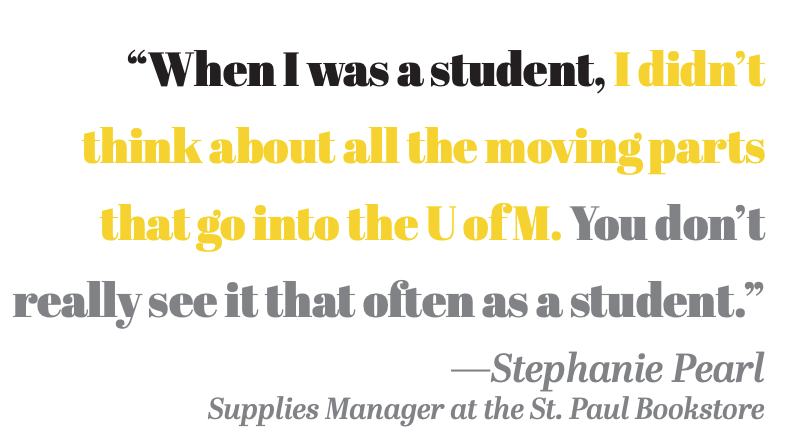
Buy the Book
Have you ever wondered what kind of work goes into making sure students and staff are prepared for class with the appropriate supplies and texts? Most of it happens at the university’s bookstores on both East Bank and St. Paul campuses. They employ both students and full-time staff who are helpful and passionate about the work they do.

Stephanie Pearl is the supplies manager at the St. Paul Bookstore. Recently, she picked up additional responsibilities and now considers herself more of an assistant manager, doing a little bit of everything around the bookstore.
Day-to-day, Pearl helps students, staff and faculty find they need to navigate their days, whether it be colored pencils for art class or software for a new computer. And perhaps not surprisingly, her favorite thing to do is help students find their assigned textbooks. “The most important thing to me is making sure that students are prepared for school and that they have the right supplies,” she says.
Since Pearl works on the St. Paul campus, she is often interacting with design students, who have a majority of their classes there. Without her, having access to the supplies needed to complete this degree would be much more difficult. “We can look at your syllabus and find the supplies you need because a lot of art and design classes have very complicated syllabi with a ton of supplies to buy,” Pearl says.
Pearl thinks that those who work behind the scenes at the university often fly under the radar. “When I was a student, I didn’t think about all the moving parts that go into the U,” she says. “You don’t really see it that often as a student.”
Because the U of M is so large, Pearl hypothesizes, it’s likely that a lot of people either take its inner workings for granted or simply can’t comprehend how many people it takes to maintain its facilities and serve its populace. She also believes that students and faculty sometimes “bundle” support staff, like the buildings they walk by or departments listed online, and they get taken for granted—or become nameless and faceless.
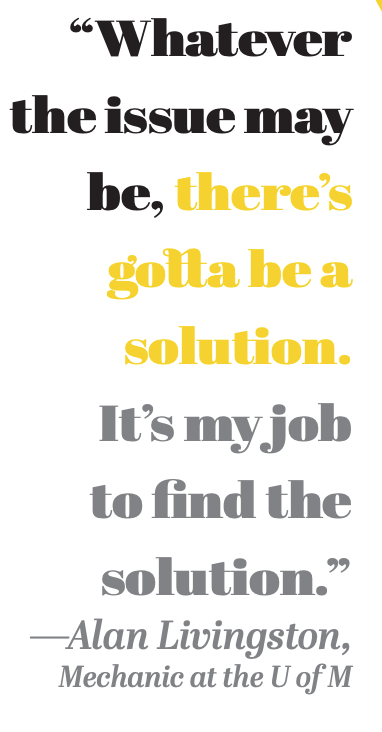
While she takes her job seriously and strives to make the university a better place for students, staff and faculty, Pearl also treasures time away from the shelves. With a novel or piece of nonfiction in tow, she enjoys traveling, especially to spots where nature has room to breathe. And if she weren’t coming back from her vacations to work at the university, she says she would likely look to do work as an interpreter. “I started learning Korean in high school and continued all the way through college,” she says. “It’s kind of a random skill to have, but it’s pretty cool.”
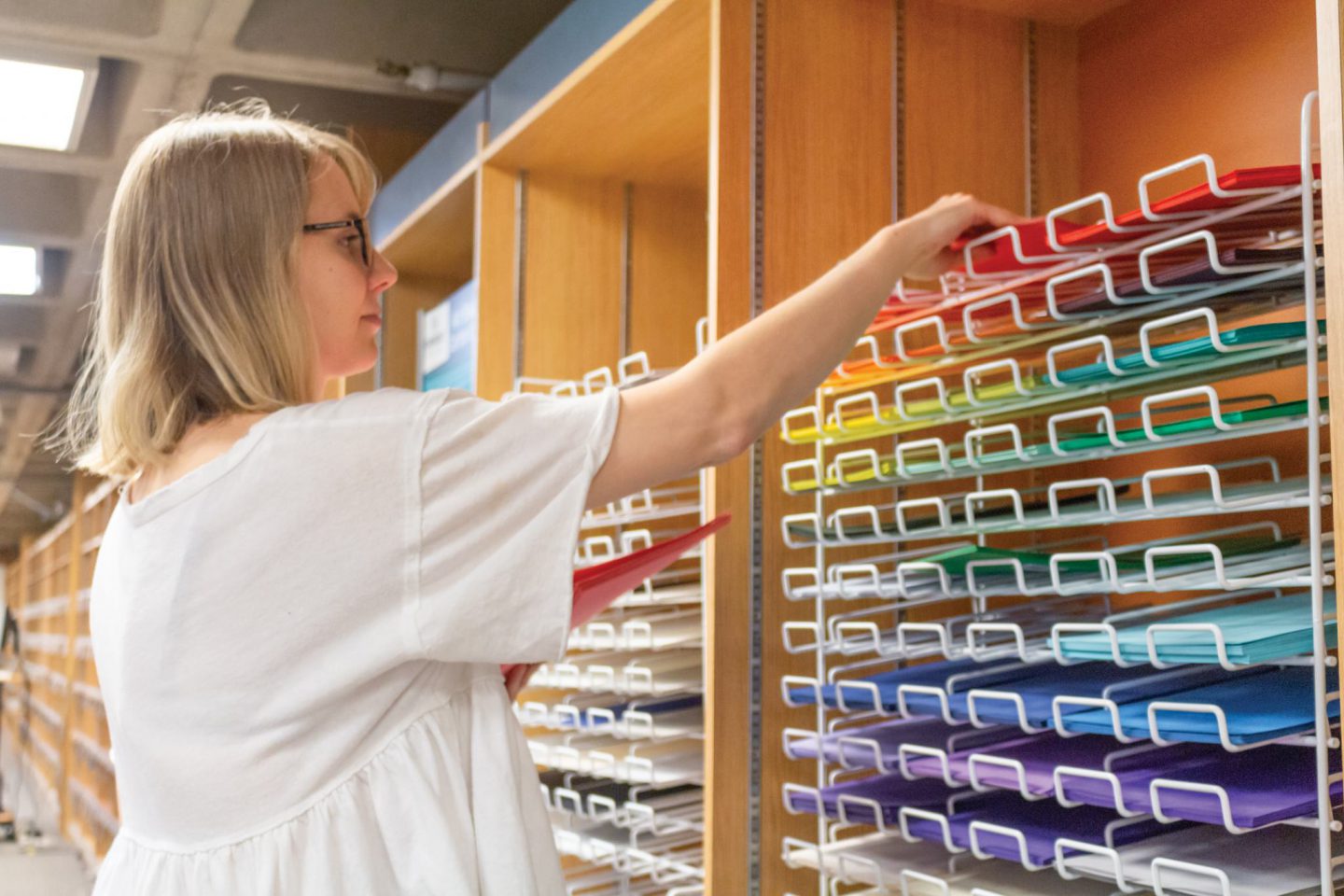
Troubleshooter
Alan Livingston is a mechanic at the university, and most of his work happens behind the scenes. While he does have an office (with a giant blow-up turkey in it), Livingston does most of his work outside of it and spends most of his time fixing anything that’s broken—such as toilets, air conditioning units and sinks.
In school, Livingston studied precision sheet metal, and for nearly 20 years, that was his profession. After that, he started flipping homes with a few friends, which is where he picked up his mechanic skills.
Livingston’s favorite part of the job is the troubleshooting. He says his work is like a puzzle, making it interesting for him. Often, he considers: What are the parts we need to fix the problem? How do we get these parts? Who’s going to pay for them?
“Whatever the issue may be, there’s gotta be a solution,” he says. “It’s my job to find the solution.”
That being said, there are some aspects of being a university mechanic Livingston could do without. Reaching down floor drains is one of them. “It’s not something I enjoy doing, but it is part of the job,” Livingston says. “I don’t like doing the grimy stuff, but it’s something I have to do and it’s something I will do.”
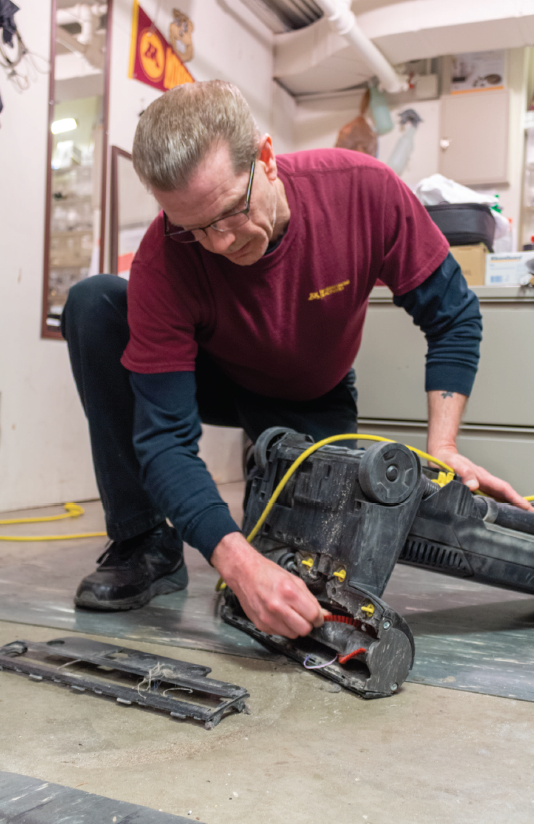
Even when he’s off the job, Livingston still makes use of his mechanic skills. This comes in the form of his most prized possession, his rebuilt 1974 Monte Carlo. “That is my toy and that is how I have fun,” he says.
Livingston’s proudest accomplishment to date is making it to 50 years old. “I never thought I’d make it to 20,” Livingston says. “I guess each year has been an accomplishment for me and also surviving it.”
Unlike Almquist and Pearl, he doesn’t think the behind-the-scenes people at the U of M are underappreciated. “You don’t have to come to me every day and tell me that I’m doing a good job,” he says. “I get compensated and that’s good enough for me.”P









